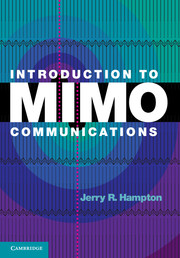Book contents
- Frontmatter
- Contents
- Preface
- 1 Overview of MIMO communications
- 2 The MIMO capacity formula
- 3 Applications of the MIMO capacity formula
- 4 RF propagation
- 5 MIMO channel models
- 6 Alamouti coding
- 7 Space-time coding
- 8 Spatial multiplexing
- 9 Broadband MIMO
- 10 Channel estimation
- 11 Practical MIMO examples
- Appendices
- References
- Index
3 - Applications of the MIMO capacity formula
Published online by Cambridge University Press: 05 December 2013
- Frontmatter
- Contents
- Preface
- 1 Overview of MIMO communications
- 2 The MIMO capacity formula
- 3 Applications of the MIMO capacity formula
- 4 RF propagation
- 5 MIMO channel models
- 6 Alamouti coding
- 7 Space-time coding
- 8 Spatial multiplexing
- 9 Broadband MIMO
- 10 Channel estimation
- 11 Practical MIMO examples
- Appendices
- References
- Index
Summary
In this chapter we study the MIMO capacity formula derived in the previous chapter to see what insight can be gained about MIMO communications. In order to study the MIMO capacity formula, it is necessary to make assumptions about the type of channel state information (CSI) that exists. In the MIMO literature, the term CSI refers to knowledge about the communications channel, which is equivalent to knowledge about the channel matrix, H. In most MIMO schemes, either the transmitter, receiver, or both must know H. When the receiver has knowledge of the CSI, we call that CSIR. Similarly, when the transmitter has knowledge of the channel, we denote that by CSIT. We will find that the predictions of the capacity formula depend on the type of CSI.
We begin by examining the capacity formula under CSIR only assumptions, which leads to the concept of eigenmodes and the importance of channel rank in characterizing MIMO performance. After that, we consider systems that have both CSIT and CSIR, which leads to the concept of eigenbeamforming. Next, we present simulation results that show the predicted capacity of MIMO systems under various assumptions. Following that discussion, we derive theoretical closed-form expressions for the capacities of SIMO and MISO systems and discuss how and why SIMO and MISO systems differ. We conclude this chapter by considering the capacities of random channels, where the concepts of ergodic and outage capacity are introduced.
- Type
- Chapter
- Information
- Introduction to MIMO Communications , pp. 42 - 69Publisher: Cambridge University PressPrint publication year: 2013



